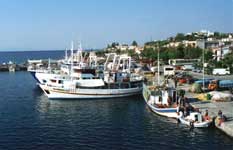.
Administrative Region : East Macedonia and Thrace
Regional unit : Evros
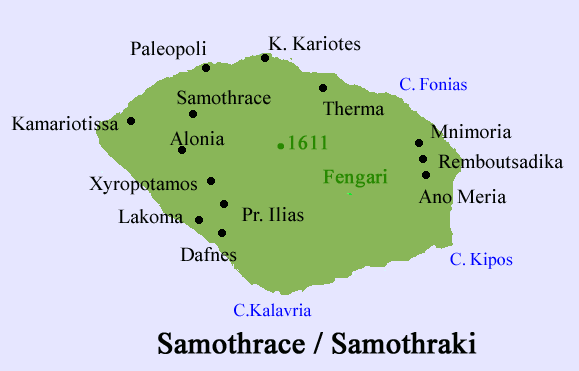
Samothrace (also Samothraki) (Greek: Σαμοθράκη, [samoˈθraci]) is a Greek island in the northern Aegean Sea. It is a self-governing municipality within the Evros peripheral unit of Thrace. The island is 17 km (11 mi) long and is 178 km2 (69 sq mi) in size and has a population of 2,723 (2001 census). Its main industries are fishing and tourism. Resources on the island includes granite and basalt. Samothrace is one of the most rugged Greek islands, with Mt. Fengari rising to 1,611 m.
History
Antiquity
The Winged Victory of Samothrace, one of the best-known ancient Greek statues.
Samothrace was not a state of any political significance in ancient Greece, since it has no natural harbour and most of the island is too mountainous for cultivation: Mount Fengari (Mount Moon) rises to 1,611 m (5,285 ft). It was, however, the home of the Sanctuary of the Great Gods, site of important Hellenic and pre-Hellenic religious ceremonies. Among those who visited this shrine to be initiated into the island cult were King Lysander of Sparta, Philip II of Macedon and Cornelius Piso, father-in-law of Julius Caesar.
The ancient city, the ruins of which are called Palaeopoli ("old city"), was situated on the north coast. Considerable remains still exist of the ancient walls, which were built in massive Cyclopean style, as well as of the Sanctuary of the Great Gods, where mysterious rites took place which were open to both slaves and free people (similar to the Eleusinian Mysteries).
The traditional account from antiquity is that Samothrace was first inhabited by Pelasgians and Carians, and later Thracians. At the end of the 8th century BC the island was colonised by Greeks from Samos, from which the name Samos of Thrace, that later became Samothrace; although Strabo denies this. The archaeological evidence suggests that Greek settlement was in the sixth century BC.
Waterfall and pond in Samothrace.
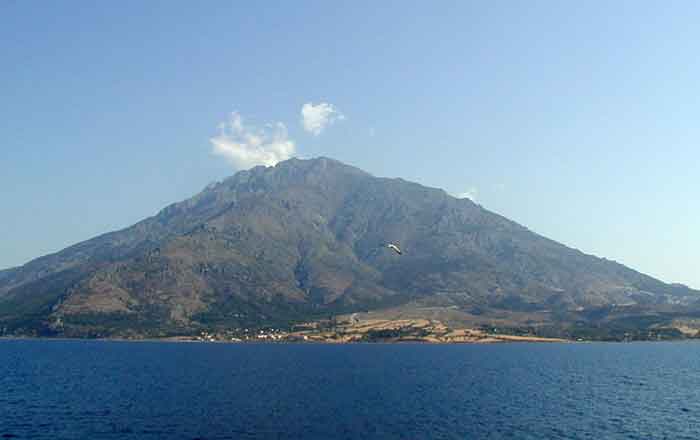
Samothrace (Source)
The Persians occupied Samothrace in 508 BC, it later passed under Athenian control, and was a member of the Delian League in the 5th century BC. It was subjected by Philip II, and from then till 168 BC it was under Macedonian suzerainity. With the battle of Pydna Samothrace became independent, a condition that ended when Vespasian absorbed the island in the Roman Empire in 70 AD.
The Book of Acts in the Christian Bible records that the Apostle Paul, on his second missionary journey outside of Palestine, sailed from Troas to Samothrace and spent one night there on his way to Macedonia. Acts 16:11
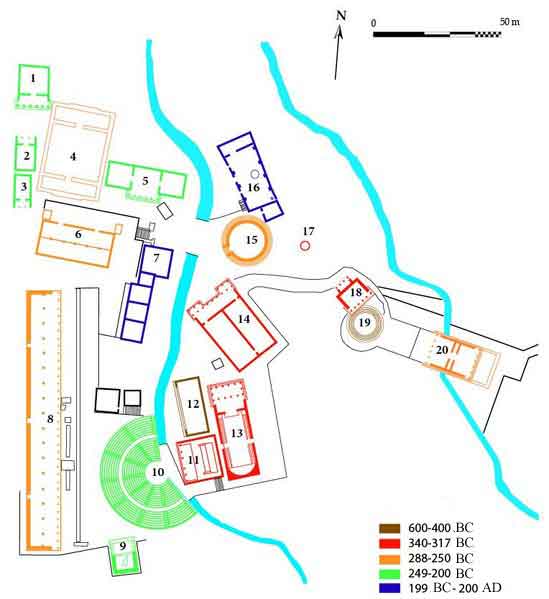
Samothrace sancturary plan (Source)
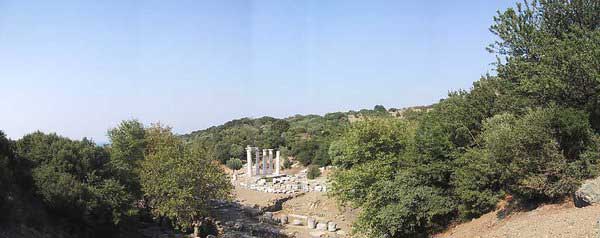
Hieron (plan 13) in Samothrace with five columns restored, in the mysteries of the Kabeiroi sancturary [Source]
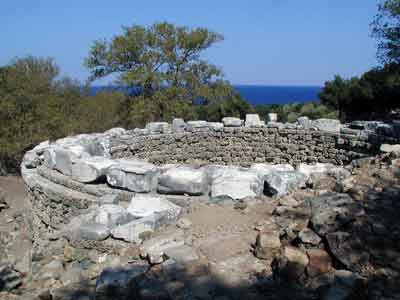
Arsinoe's rotunda in Samothrace , dedicated to the gods by Arsinoe II of Egypt, wife of Lysimachus (Plan number 15) [Source] . The Rotunda is the largest closed, round building known from Greek architecture. ReconstructionArsinóeion, Arsinoe II, Samothrace, August 2001 [Source]
See :Karl Lehmann , Samothrace, Volume 7: The Rotunda of Arsinoe, 1992 , Princeton University Press ; ISBN: 0691099197
Post-Roman Era
Samothrace, with Mt. Fengari in the background.
St. Theophanes died here in 818. The Byzantines ruled till 1204, when Venetians took their place, only to be dislodged by a Genoan family in 1355, the Gattilusi. The Ottoman Empire conquered it in 1457 and was called Turkish: Semadirek; an insurrection against them by the local population during the Greek War of Independence (1821–1831) led to the massacre of most of the population. The island returned to Greek rule in 1913 following the Balkan War. It was briefly occupied by Bulgaria during the Second World War.
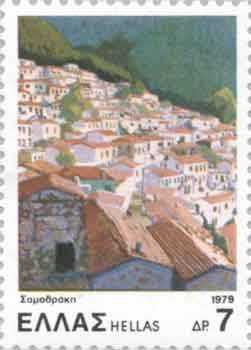
Today
The modern port town of Kamariotissa is on the north-west coast and provides ferry access to and from points in northern Greece such as Alexandroupoli and Kavala. There is no commercial airport on the island. Other sites of interest on the island include the ruins of Genoese forts, the picturesque Chora (old town), and several waterfalls.
Landmarks
A picturesque view of the Hieron
One of the numerous ponds characteristic of the island.

The island's most famous site is the Sanctuary of the Great Gods, Greek Hieron ton Megalon Theon ; the most famous artifact of which is the 2.5-metre marble statue of Nike, now known as the Winged Victory of Samothrace, dating from about 190 BC. It was discovered in pieces on the island in 1863 by the French archaeologist Charles Champoiseau, and is now - headless - in the Louvre in Paris.
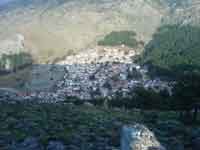
Municipality Samothraki(Seat: Σαμοθράκη, η) |
|---|
| Alonia (Αλώνια, τα) |
| Ano Karyotes (Άνω Καρυώται, οι) |
| Ano Meria (Άνω Μεριά, η) |
| Dafnes (Δάφνες, οι) |
| Therma (Θέρμα, τα) |
| Kamariotissa (Καμαριώτισσα, η) |
| Katsampas (Κατσαμπάς, ο) |
| Kato Karyotes (Κάτω Καρυώται, οι) |
| Lakkoma (Λάκκωμα, το) |
| Makrylies (Μακρυλιές, οι) |
| Xiropotamos (Ξηροπόταμος, ο) |
| Palaiopoli (Παλαιόπολις, η) |
| Potamia (Ποταμιά, η) |
| Profitis Ilias (Προφήτης Ηλίας, ο) |
| Samothraki (Town) (Σαμοθράκη, η) |
Historical population
Year Island population
1981 2,871
1991 3,083
2001 2,723
See also
Communities of the Evros prefecture
Samothrace temple complex
Winged Victory of Samothrace
References
On the Divinities of Samothrace Paperback – September 14, 2019 by F.W.J. Schelling (Author), Frank Scalambrino
The Great Gods of Samothrace and The Cult of the Little People
Michel Mourre, Dictionnaire Encyclopédique d'Histoire, article Samothrace, Bordas, 1996
Marcel Dunan, Histoire Universelle, Larousse, 1960
| Ancient Greece
Science, Technology , Medicine , Warfare, , Biographies , Life , Cities/Places/Maps , Arts , Literature , Philosophy ,Olympics, Mythology , History , Images Medieval Greece / Byzantine Empire Science, Technology, Arts, , Warfare , Literature, Biographies, Icons, History Modern Greece Cities, Islands, Regions, Fauna/Flora ,Biographies , History , Warfare, Science/Technology, Literature, Music , Arts , Film/Actors , Sport , Fashion --- |
Retrieved from "http://en.wikipedia.org/"
All text is available under the terms of the GNU Free Documentation License


